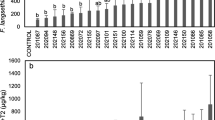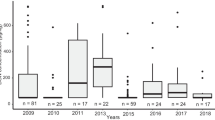Abstract
Lodging is one possible risk factor that leads to increased cereal mycotoxin contamination, but few reports have been published on the subject. We examined the effects of lodging on the level of deoxynivalenol (DON) and nivalenol (NIV) contamination in wheat, barley, and rice infected with the Fusarium graminearum species complex. Case-control and intervention studies were applied to test the hypothesis that lodging increases the level of mycotoxin contamination. A total of 66 grain samples were collected from each field in 12 Japanese prefectures from 2002 to 2006. Each sample set consisted of grains from lodged and nonlodged plants. The concentration of DON + NIV in lodged plants was significantly higher than in nonlodged plants. All samples of wheat and barley were contaminated with DON and NIV; however, most of the lodged rice samples were contaminated only with NIV. In intervention trials to investigate the effects of lodging duration, a small area of wheat inoculated with the pathogen was completely lodged by trampling. Even with 5 days of lodging, the levels of DON + NIV in wheat grain at harvest increased by 27–51% compared to nonlodged control plots. For rice, half of each plot area was completely lodged by trampling 20 days before harvest. The level of NIV in lodged rice grain was significantly higher than that in nonlodged rice at optimum and delayed harvests, because lodging significantly increased the level of Fusarium mycotoxins in the three crops. Thus, practices (e.g., rational use of fertilizers) to avoid lodging should reduce the risk of mycotoxin contamination. This is the first epidemiological study on the effect of lodging on mycotoxin production by the F. graminearum species complex in wheat, barley, and rice.




Similar content being viewed by others
References
Atanasoff D (1920) Fusarium-blight (scab) of wheat and other cereals. J Agric Res 20:1–32
Easson DL, White EM, Pickles SJ (1993) The effects of weather, seed rate and cultivar on lodging and yield in winter wheat. J Agric Sci 121:145–156
Farrer D, Weisz R, Heiniger R, Murphy JP, Pate MH (2006) Delayed harvest effect on soft red winter wheat in the southeastern USA. Agron J 98:588–595
Fischer RA, Stapper M (1987) Lodging effects on high-yielding crops of irrigated semi-dwarf wheat. Field Crops Res 17:245–248
Ichinoe M, Hagiwara H, Kurata H (1984) Distribution of trichothecene-producing fungi in barley and wheat fields in Japan. In: Kurata H, Ueno Y (eds) Toxigenic fungi: their toxins and health hazard. Elsevier, Tokyo, pp 190–198
Koizumi S, Kato H, Yoshino R, Hayashi N, Ichinoe M (1991) Distribution of causal Fusaria of wheat and barley scab in Japan. Ann Phytopath Soc Jpn 57:165–173
Langseth W, Stabbetorp H (1996) The effect of lodging and time of harvest on deoxynivalenol contamination in barley and oats. J Phytopathol 144:241–245
Lauren DR, Jensen DJ, Smith WA, Dow BW, Sayer ST (1996) Mycotoxins in New Zealand maize: a study of some factors influencing contamination levels in grain. NZ J Crop Horticult Sci 24:13–20
Lee T, Han Y-K, Kim K-H, Yun S-H, Lee Y-W (2002) Tri13 and Tri7 determine deoxynivalenol- and nivalenol-producing chemotypes of Gibberella zeae. Appl Environ Microbiol 68:2148–2154
Minervini F, Fornelli F, Flynn KM (2004) Toxicity and apoptosis induced by the mycotoxins nivalenol, deoxynivalenol and fumonisin B1 in a human erythroleukemia cell line. Toxicol In Vitro 18:21–28
Nakajima T, Yoshida M (2007) Mycotoxin productivity and virulence of Fusarium graminearum species complex causing Fusarium head blight on wheat and barley in the western part of Japan. Jpn J Phytopathol 73:106–111 (in Japanese with English abstract)
Nicholson P, Turner JA, Jenkinson P, Jennings P, Stonehouse J, Nuttall M, Dring D, Weston G, Thomsett M (2003) Maximising control with fungicides of Fusarium ear blight (FEB) in order to reduce toxin contamination of wheat. In Project Report No. 297, HGCA, London, pp 1–85
O’Donnell K, Kistler HC, Tacke BK, Casper HH (2000) Gene genealogies reveal global phylogeographic structure and reproductive isolation among lineages of Fusarium graminearum, the fungus causing wheat scab. Proc Natl Acad Sci USA 97:7905–7910
O’Donnell K, Ward TJ, Geiser DM, Kistler HC, Aoki T (2004) Genealogical concordance between the mating type locus and seven other nuclear genes supports formal recognition of nine phylogenetically distinct species within the Fusarium graminearum clade. Fungal Genet Biol 41:600–623
Park JW, Choi SY, Hwang HJ, Kim YB (2005) Fungal mycoflora and mycotoxins in Korean polished rice destined for humans. Int J Food Microbiol 103:305–314
Pinthus MJ (1973) Lodging in wheat, barley and oats: The phenomenon, its causes and preventative measures. Adv Agron 25:209–263
Placinta CM, D’Mello JBF, MacDonald AMC (1999) A review of world contamination of cereal grains and animal feeds with Fusarium mycotoxins. Anim Feed Sci Technol 78:21–37
Ryu JC, Ohtsubo K, Izumiyama N, Nakamura K, Tanaka T, Yamamura H, Ueno Y (1988) The acute and chronic toxicities of nivalenol in mice. Fund Appl Toxicol 11:38–47
Suga H, Karugia GW, Ward T, Gale LR, Tomimura K, Nakajima T, Miyasaka A, Koizumi S, Kageyama K, Hyakumachi M (2008) Molecular characterization of the Fusarium graminearum species complex in Japan. Phytopathology 98:159–166
Takahashi M, Shibutani M, Sugita-Konishi Y, Aihara M, Inoue K, Woo GH, Fujimoto H, Hirose M (2007) A 90-day subchronic toxicity study of nivalenol, a trichothecene mycotoxin, in F344 rats. Food Chem Toxicol 46:125–135
Tanaka K, Kobayashi H, Nagata T, Manabe M (2004a) Natural occurrence of trichothecenes on lodged and water-damaged domestic rice in Japan. J Food Hyg Soc Jpn 45:63–66
Tanaka T, Hasegawa A, Yamamoto S, Lee US, Sugiura Y, Ueno Y (1988) Worldwide contamination of cereals by the Fusarium mycotoxins nivalenol, deoxynivalenol, and zearalenone. 1. Survey of 19 countries. J Agric Food Chem 36:979–983
Tanaka T, Yoshizawa T, Tanaka T, Sugiura Y, Takatori K, Kumagai S (2004b) Contamination of staple cereals with deoxynivalenol and nivalenol in Japan. In: Yoshizawa T (ed) New horizon of mycotoxicology for assuring food safety. Bikohsha, Takamatsu, pp 83–88
Togawa M (1994) Selective medium for isolation of Fusarium graminearum. Soil Microorg 44:77–88 (in Japanese with English abstract)
Ueno Y, Aikawa Y, Okumura H, Sugiura Y, Nakamura K, Masuma R, Tanaka T, Young CJ, Savard ME (1997) Trichothecenes produced by Fusarium species Fn 2B. Mycotoxins 45:25–31
Ward TJ, Bielawski JP, Kistler HC, Sullivan E, O’Donnell K (2002) Ancestral polymorphism and adaptive evolution in the trichothecene mycotoxin gene cluster of phytopathogenic Fusarium. Proc Natl Acad Sci USA 99:9278–9283
Welling B (1975) Lodging and cereal quality. Investigation on germination capacity and fungus flora at harvest and after storage of lodged cereal crop. Tidsskrift Planteavl 79:243–253
Wilson JP, Casper HH, Wilson DM (1995) Effect of delayed harvest on contamination of pearl millet grain with mycotoxin-producing fungi and mycotoxins. Mycopathologia 132:27–30
Yoshida M, Kawada N, Nakajima T (2007) Effect of infection timing on Fusarium head blight and mycotoxin accumulation in open- and closed-flowering barley. Phytopathology 97:1054–1062
Yoshizawa T, Jin YZ (1998) Trichothecene occurrence in Japanese wheat and barley—its characteristics. Mycotoxins 47:15–18
Yoshizawa T, Kohno H, Ikeda K, Shinoda T, Yokohama H, Morita K, Kusada O, Kobayashi Y (2004) A practical method for measuring deoxynivalenol, nivalenol, and T-2 + HT-2 toxin in foods by an enzyme-linked immunosorbent assay using monoclonal antibodies. Biosci Biotechnol Biochem 68:2076–2085
Zadoks JC, Chang TT, Konzak CF (1974) A decimal code for the growth stages of cereals. Weed Res 14:415–421
Acknowledgments
The authors thank everyone who helped collect samples and the staff of the research team for FHB control at KONARC for technical assistance. This study was conducted as part of the Integrated Research Program for Functionality and Safety of Food toward an Establishment of Healthy Diet. Funding was provided by the Ministry of Agriculture, Forestry and Fisheries of Japan.
Author information
Authors and Affiliations
Corresponding author
Rights and permissions
About this article
Cite this article
Nakajima, T., Yoshida, M. & Tomimura, K. Effect of lodging on the level of mycotoxins in wheat, barley, and rice infected with the Fusarium graminearum species complex. J Gen Plant Pathol 74, 289–295 (2008). https://doi.org/10.1007/s10327-008-0103-7
Received:
Accepted:
Published:
Issue Date:
DOI: https://doi.org/10.1007/s10327-008-0103-7




